Gigabyte GA-A55M-S2V Review
by Brendan van Varik on March 21, 2012 9:00 PM EST- Posted in
- Motherboards
- Gigabyte
- Llano
- A55
USB Speed
For this benchmark, we run CrystalDiskMark to determine the ideal sequential read and write speeds for the USB port using our 64GB Patriot SuperSpeed USB 3.0 drive. Then we transfer a set size of files from the SSD to the USB drive, and monitor the time taken to transfer. The files transferred are a 1.52 GB set of 2867 files across 320 folders – 95% of these files are small typical website files, and the rest (90% of the size) are the videos used in the Sorenson Squeeze test.
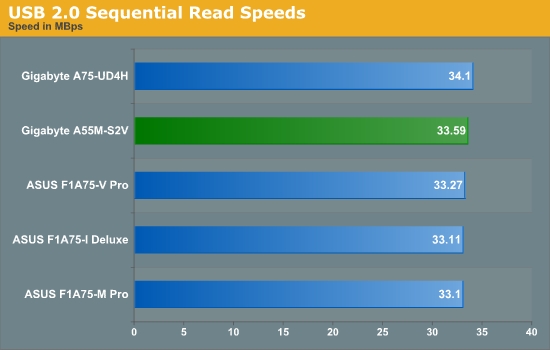
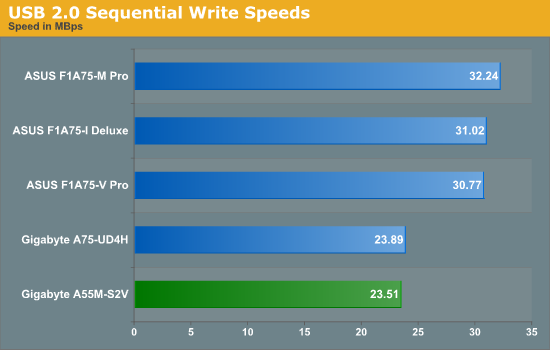
Read speeds on the A55M-S2V are good and they are above average – the write speeds on the other hand are not great.
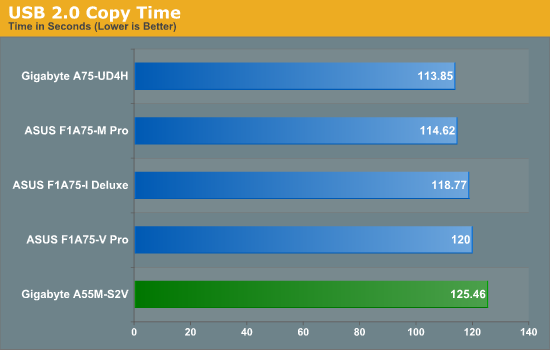
Due to the write speeds being low, the copy time is naturally affected by this.
SATA Testing
We also use CrystalDiskMark for SATA port testing. The operating system is installed on the SSD, and the sequential test is run at the 5 x 1000 MB level. This test probes the efficiency of the data delivery system between the chipset and the drive, or in the case of additional SATA ports provided by a third party controller, the efficiency between the controller, the chipset and the drive.
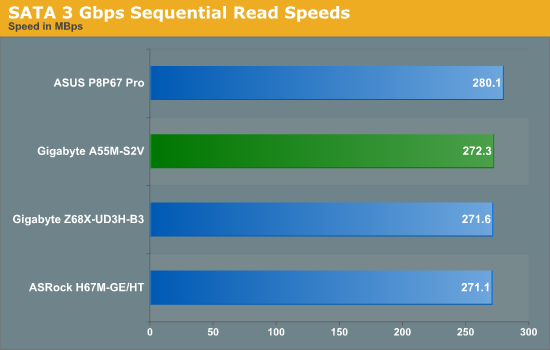
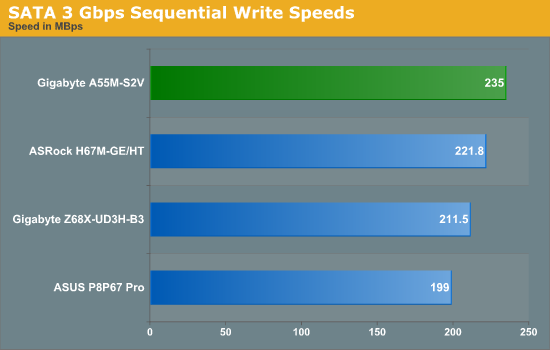
As SATA 3 Gbps is not on the A75 platform due to it being SATA 6 Gbps native, I have decided to compare it to the mid ranged, H67 platform.
DPC Latency
Deferred Procedure Call latency is a way in which Windows handles interrupt servicing. In order to wait for a processor to acknowledge the request, the system will queue all interrupt requests by priority. Critical interrupts will be handled as soon as possible, whereas lesser priority requests, such as audio, will be further down the line. So if the audio device requires data, it will have to wait until the request is processed before the buffer is filled. If the device drivers of higher priority components in a system are poorly implemented, this can cause delays in request scheduling and process time, resulting in an empty audio buffer – this leads to characteristic audible pauses, pops and clicks. Having a bigger buffer and correctly implemented system drivers obviously helps in this regard. The DPC latency checker measures how much time is processing DPCs from driver invocation – the lower the value will result in better audio transfer at smaller buffer sizes. Results are measured in microseconds and taken as the peak latency while cycling through a series of short HD videos - under 500 microseconds usually gets the green light, but the lower the better.
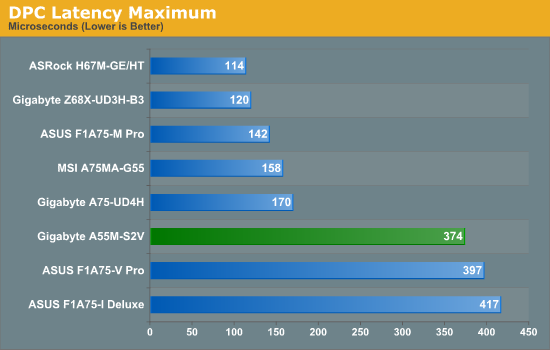
The result for this motherboard comes in the middle of the five Llano boards we have currently tested. There seems to be an effect here on certain types of boards with the DPC Latency as well, but nonetheless they all come in at under the golden marker of 500 microseconds.










21 Comments
View All Comments
seanleeforever - Thursday, March 22, 2012 - link
why not just purchase some DC power supply and take the read out directly? what the system will suck out of the socket can be computed by the efficiency of your PSU at that particular load. (say the system uses 100W, and you know your PSU has 80% efficiency at 100W, then you can compute that you system will suck out 120W from the wall)speaking of which, when will anandtech actually buy some product for testing instead of taking what manufacture 'supplied' parts? because we all know there is absolutely no any conflict of interest when a manufacture 'send' you their 'regular' product for 'free' for this website to write an great review to 'speak truth' about their product.
Shadowmaster625 - Thursday, March 22, 2012 - link
Actually a 5850 is a smart choice. Maybe not this particular version, but a generic 5850. One might find such a beast for under $100 on ebay at some point in the next 6 months. That would be a great deal for a value gamer.Ratman6161 - Thursday, March 22, 2012 - link
I'm in the process of decision making for a low cost, small form factor system for my wife to use. I'm comparing Intel i3 Vs Llano and finding I can get an i3 2125 or a AMD A8 38xx for about the same price and to me it comes down to graphics performance. My take:1. If you want to get the best processing power, go with i3
2. If you want the best graphics you can get without the need for a pci-e card, and processing power is not that important to you get llano.
3. If you want processing power and better graphics too, get i3 with a pci-e card
4. If you want better graphics than Llano offers, once again its i3 with pci-e card
So the only scenario (at least for me) where AMD makes sense is #2 which actually happens to be what we are looking for. Testing it with an add on card doesn't help me. And if you wanted to use AMD with an add on card, you could just go with a cheap Athlon X4 - as you wouldn't need the graphics on the Llano cpu anyway.
loimlo - Saturday, March 24, 2012 - link
Yes, I'd like to see power consumption figures without a discrete VGA. I'm fine with 5850 given it's a requirement of formula across motherboard reviews, but something like integrated VGA would be welcomed.Btw, does Anandtech consider using smaller PSU in the future review? It seems ridiculous to use 1250W for such an entry-level product. It's unrealistic for mass deployment and inefficient at such low load.
ssj3gohan - Thursday, March 22, 2012 - link
It's good to see other people complaining about this, too. Power consumption is, especially compared to the high quality of their other reviews and articles, an underdeveloped appendage at Anandtech.ssj3gohan - Thursday, March 22, 2012 - link
A lot of sentences and general flow of this article are in my opinion sub-par for a site like AnandTech. It seems like this article was first written in Dutch and then translated straight up sentence-by-sentence into English. It would really help readability if the article were edited by a native speaker.silverblue - Thursday, March 22, 2012 - link
You may wish to provide examples as I don't see what you're referring to. In my eyes, it's a very comprehensible article and I haven't had to read something twice to decipher what the author is trying to get across.Taft12 - Thursday, March 22, 2012 - link
I felt the same way as ssj3gohan when I read the article, here's 3 awkward sentences in a row:"The blue PCB which the GA-A55M-S2V is built on is a typical sighting from the current Gigabyte budget segment. Keen eyes will notice the lack of VRM heatsinks, despite this board being certified to run 100W processors. This will undoubtledly lead to little room in terms of pushing the platform."
Don't get me wrong however, this is a good review and bravo to Anandtech for reviewing more entry-level components. Just peer-review them before putting it live.
ggathagan - Thursday, March 22, 2012 - link
There's absolutely nothing wrong with any of those sentences.The closest to "awkward" one could get would be the use of "a typical sighting".
Even that, however, is a somewhat common turn of phrase.
If I wrote tech reviews for a popular website, I would get very tired of writing essentially the same thing over and over again.
In that circumstance, I would certainly try to inject a little variety by doing exactly what Brendan appears to have done.
silverblue - Friday, March 23, 2012 - link
The only thing I could recommend here is adding a small amount of punctuation, but that's it. For example:"The blue PCB - which the GA-A55M-S2V is built on - is a typical sighting from the current Gigabyte budget segment."